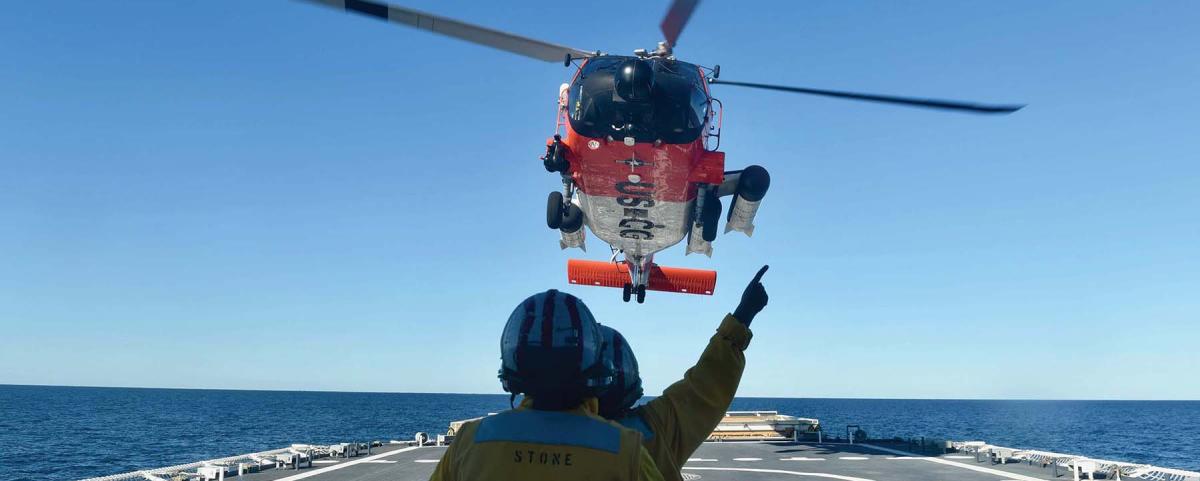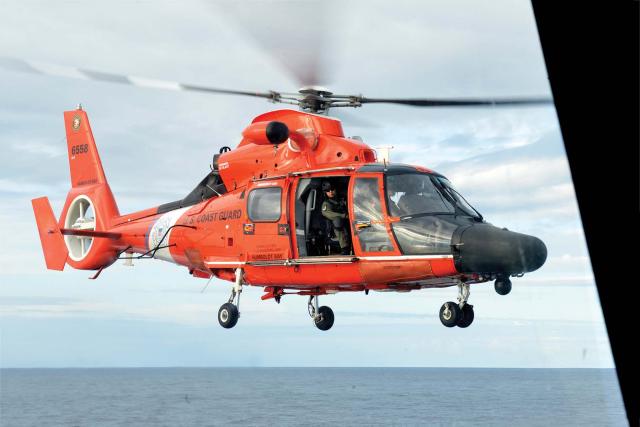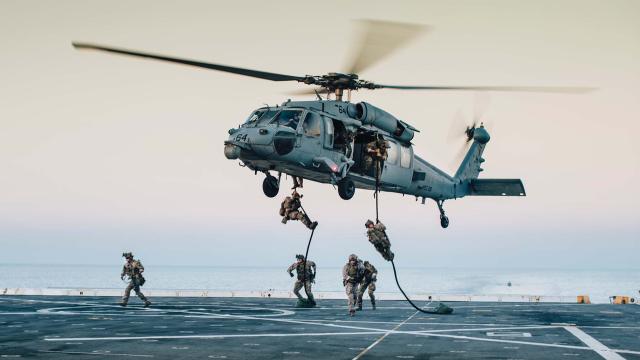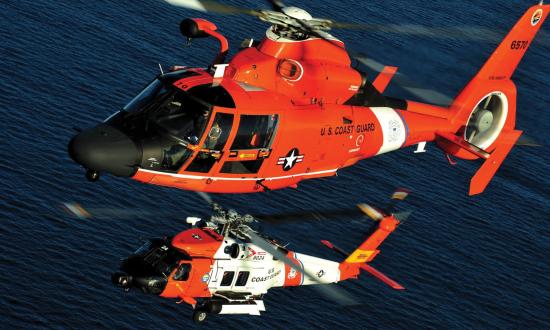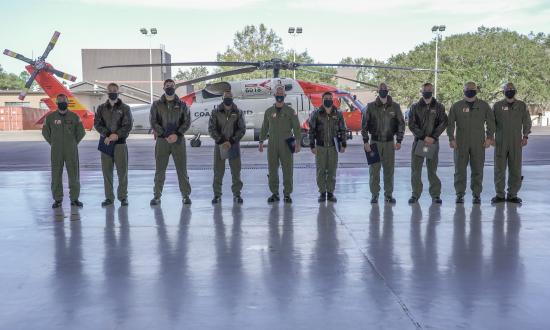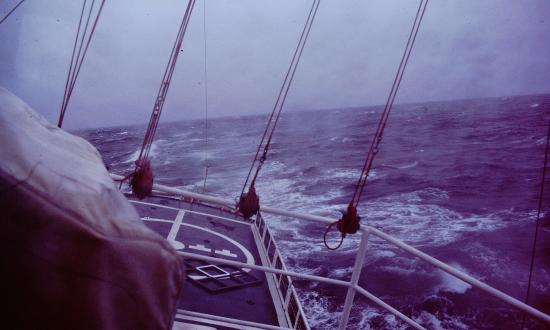Post–9/11 force restructuring, sweeping asset recapitalization, and unique authorities have made the Coast Guard the “next big thing in Washington policymaking.”1 From regular white-hull deployments in the western Pacific and Oceana to Advantage at Sea, the tri-service maritime strategy, the service is in the international spotlight. While expansion of the cutter fleet portends well for its ability to operate within the joint force, the Coast Guard will not be able to make a credible contribution beyond gross tonnage until it fully embraces air power.
The Coast Guard must view aircraft as a force multiplier, fully embedded in cutter operations. Commandant of the Coast Guard Admiral Karl Schultz has made it clear the service is phasing out the MH-65 in favor of the MH-60T, as it should, but it needs to do so with a laser focus on shipboard aviation and cutter deployment—to address capability gaps at sea.
Replace the MH-65
The Coast Guard is no stranger to shipboard aviation—having made its first shipboard helicopter landing in 1944—but the current state of affairs does not reflect an institutional priority.2 The pride of the Coast Guard’s aviation fleet is the Helicopter Interdiction Tactical Squadron (HITRON). Formed in 2000, HITRON’s signature is airborne use of force, shooting out the engines of go-fast drug-smuggling vessels.3 This trademark capability, along with fast, modern small boats, breathed new life into aging Coast Guard cutters and transformed the way maritime drug interdictions are prosecuted. However, 20 years on, the shipboard aviation fleet is decaying, despite the extraordinary efforts of maintainers.
The MH-65 Dolphin is on its last legs. Ninety-eight of these airframes were acquired in 1984, and they are no longer produced.4 New spare parts are not available, and fleet aviation engineering resources find themselves fabricating custom electronics and associated hardware to keep the Dolphins operational.5 The Coast Guard should transition from the MH-65 Dolphin to the eminently more capable blade- and tail-fold variant of the MH-60T as its primary shipboard aviation platform.
In addition to supercharging the new, cutting-edge Coast Guard platforms, such as the national security cutter and offshore patrol cutter, transitioning to the same airframe as the Navy will provide the Coast Guard true interoperability. A cutter with an embarked MH-60T can fully integrate into joint surface action groups and will be a valued member of any joint maritime force.
Further, MH-60Ts will empower some of the Coast Guard’s unique law enforcement capabilities. With a robust fleet of MH-60Ts, the Coast Guard will not be constrained to the use of small boats or have to rely on Defense Department helicopter availability to employ its signature maritime security response teams (MSRTs), highly trained operators who train to fast-rope onto vessels from MH-60 helicopters. The Coast Guard could explore training its broader stable of tactical law enforcement operators—such as the counternarcotics-focused tactical law enforcement teams and security-focused maritime safety and security teams—on fast-rope insertion from MH-60 variants. By purchasing and maintaining a shipboard fleet of MH-60Ts, the Coast Guard would empower a capability that no other maritime service can bring to the table.
Embarking the MH-60 platform on board Coast Guard cutters is not a new notion; it has been kicked around wardrooms in the fleet for years. Although the service maintains shore-based MH-60s, there have been barriers to their permanent shipboard use for airborne use of force and other missions. At the tactical level, hangar space has been a lingering issue and the primary reason the MH-60 was not integrated fully for shipboard use years ago. Fortunately, this hurdle may be gone. In his annual State of the Coast Guard Address, Admiral Schultz announced he had seen the first folding-rotor MH-60T variant at Air Station Elizabeth City.6 This is the first step toward realizing a superior shipboard aviation fleet—one that must be accelerated.
Structural and Cultural Considerations
Budgets communicate priorities, and Coast Guard leaders could be forgiven if mothballing the MH-65 fleet in favor of a larger—and more expensive—helicopter did not trump recapitalization of the cutter fleet.7 But if the MH-60s hitch their wagon to the cutter community, they are more likely to realize a positive outcome in the budget. For the cutter community, embracing the largely untapped potential of the highly capable MH-60 variants is key to exploiting the full range of its capabilities to affect sea power. Tying Coast Guard missions to the broader national defense narrative is a winning acquisition strategy. One need only look to the aptly named polar security cutter acquisition program for proof. How many more years would the Coast Guard have languished without a replacement for the Polar-class icebreakers without such a nexus between national security and the polar regions?
Fleetwide implementation of MH-60Ts would require major revisions to force structure. The Coast Guard is already paying aviators incentive pay to stay in the service.8 It would have to grapple with retaining a sufficient number of pilots to maintain vital shore-based search and rescue while meeting its growing scope of global aviation responsibilities. Further, one of the oft-cited perks of Coast Guard aviation is that it does not require deployment; at present, only HITRON consistently deploys on board ships.
The Coast Guard could consider adopting a squadron-based model, similar to Navy MH-60 squadrons that regularly deploy to sea. In addition, it might finally implement what has been whispered for years: standing up a HITRON West and East. Following the model of the tactical law enforcement teams and maritime safety and security teams, a dual-coast model could help meet the demand for Coast Guard shipboard air power.
Strategic Considerations
From a strategic perspective, the advantages of transitioning airframes are threefold. First, a transition would provide immediate gains in range, speed, and loiter time in executing the counterdrug mission, currently the service’s main shipboard aviation mission. Second, it would give the Coast Guard an opportunity to fully integrate the MH-60T into routine shipboard deployments and missions, including migrant interdiction, fisheries enforcement, and large-scale disaster relief. In this vein, it also would allow the Coast Guard to synergize existing service capabilities, such as the specialized capabilities of MSRT operators. Third, the ability to train and operate with Department of Defense maritime partners would yield enormous dividends in near-term gray zone operations in contested waters and future naval conflicts.
With an embarked MH-60T, Coast Guard cutters operating in the western Pacific would be able to integrate seamlessly with a surface action group or a maritime force with U.S. Navy and allied maritime components. The ability to carry out the same missions as the Navy with the same airframe would be a boon to interoperability and hews to the triservice strategy’s call to develop an “integrated all-domain maritime force.”9 To this end, the navies of three vital allies in the region—India, Australia, and South Korea—currently employ or have purchased MH-60 variants for shipboard use.10
Other benefits of a fleet-wide MH-60T roll-out would include augmented antisubmarine warfare (ASW) and the integration of the Coast Guard’s unique law enforcement authorities and specialized law enforcement teams. At the mention of ASW, critics often declare that the Coast Guard does not need to venture into the Indo-Pacific and take on additional Department of Defense responsibilities. However, considering the Chinese submarine fleet is 75 boats and counting, and “antisubmarine warfare requires large numbers of ships and aircraft to counter each enemy submarine,” the U.S. naval services and their allies will need all the ships they can muster.11
One need only recall the Coast Guard’s experience during World War II while executing convoy duty to realize ASW is not a departure from its core competencies, but rather a return to its Title 10 responsibilities.12 Through the prism of Advantage at Sea, the Coast Guard’s involvement in ASW is a realistic expectation in the coming years, and MH-60 helicopters will be a critical component of its success. By embarking the MH-60Ts, the service will be taking its first steps toward the integrated force packages and operations the triservice strategy demands.
An Obvious Choice
The current shipboard aviation fleet is inadequate for the global missions the Coast Guard is being called on to execute. The service must invest at best speed in tomorrow’s aviation fleet, with an emphasis on incorporating the helicopter fully into shipboard evolutions. The MH-60T is the obvious choice to realize this vision.
1. Craig Hooper, “Almost Overnight, New Ships Make U.S. Coast Guard a Big Geopolitical Player,” Forbes, 26 March 2021.
2. “The Growth Years: 1939–1956,” Coast Guard Aviation Association.
3. “2001—Coast Guard Helicopter Interdiction Tactical Squadron (HITRON) Established,” Coast Guard Aviation Association.
4. Ben Werner, “In Budget Squeeze, Coast Guard Set to Extend Life of Dolphin Helicopter Fleet,” USNI News, 29 October 2018.
5. Dan Parsons, “U.S. Coast Guard ‘Absolutely’ Part of Larger Future Vertical Lift Effort,” Vertical, 14 April 2020.
6. “State of the Coast Guard 2021 by ADM K. L. Schultz, U.S. Coast Guard,” 11 March 2021.
7. Stew Magnuson, “Coast Guard Ship Modernization under Full Steam,” National Defense, 3 March 2021.
8. All Coast Notice 089/18, “FY19 Workforce Planning SitRep 4—Officer Interventions,” 30 August 2018.
9. Advantage at Sea, December 2020.
10. Dan Parsons, “India Buys Two Dozen MH-60R Sub-hunting Helicopters for $900 Million,” Vertical, 15 May 2020; Brian Kim, “South Korea to Order 12 MH-60R Antisubmarine Helicopters,” Defense News, 16 December 2020; and Royal Australian Navy, “MH-60R Seahawk.”
11. CAPT Walker D. Mills, USMC, and LCDRs Collin Fox, Dylan Phillips-Levine, and Trevor Phillips-Levine, USN, “Implementing Expeditionary ASW,” U.S. Naval Institute Proceedings 147, no. 4 (April 2021).
12. CDR Craig T. Allen, USCG, “Coast Guard Must Prepare to ‘Fight Tonight,’” U.S. Naval Institute Proceedings 146, no. 12 (December 2020); and David Van Dyk, “Bring Back Coast Guard Sub Hunters,” U.S. Naval Institute Proceedings 146, no. 9 (September 2020).



